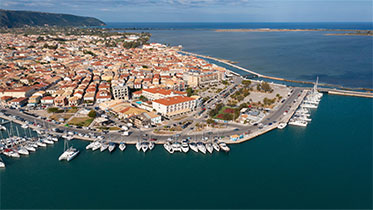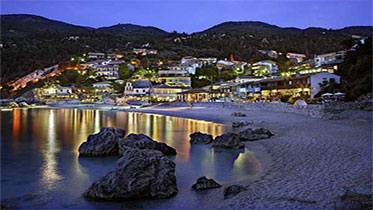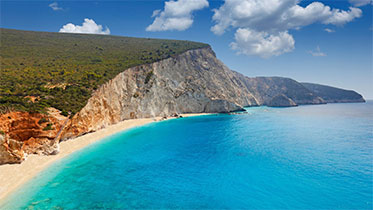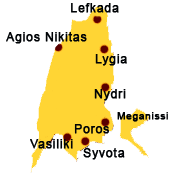|
Lefkada Island
Lefkada is predominantly mountainous. On the mountain slopes, people have built "pezoules" to exploit every part of the land. Lefkada is joined with Etoloakarnania by a thin lane of land, 25 m long. The island has a population of 20,000 inhabitants.The fauna of Lefkada include rare species of birds, wild geese, pelicans etc.The Ionian Islands suffer from frequent earthquakes, as in this area, according to geologists, there are quake breaches. This fact, is a reason for the steep coasts on the western side, which create a scenery of unique beauty. The most destructive earthquakes in Lefkada took place in 1825 and 1948. The General Administrator of Ionian Islands, Dophin, in the early 18th century, praised the bravery of the locals, calling them "restless and impulsive spirits", while the French Ambassador, Andre Grassel, describes the locals of the 18th century as "quiet" and "easy to convince". Nevertheless, current events and the island's history prove that the people of Lefkada are brave and determined. Today, they like to promenade on the road by the sea, which is the center of cultural and social activity and they gather in the quiet, traditional coffee shops to drink and talk while listening to guitars. Magnificent beaches are all over the island. Egremnoi, Kathisma, Mylos and Porto Katsiki are the most famus. The capital of the island is a beautiful town build near the harbor. Nidri is the most popular spot in Lefkada, which according to the archaeologist Dorpfeld was Homer's Ithaca. Agios NIkitas and Vasiliki are the most picturesque villages.
By a small ferry boat from Nidri you can explore the small island of Meganissi and have a view of the famous island of Scorpios which belongs to the heirs of Aristotle Onassis.
History According to mythology, the first inhabitants were the Leleges. The island was named after its most southern part, the cape of Lefkata, with its steep white rocks, from where, according to myth, those who could not endure the torture of love fell, one of them being the great poetess Sapfo. In the Middle Bronze Era, the civilization of the island was formed by Televoes, living on the islet of Meganissi. Televoes occupied the Ionian Islands and fought the Mycenaean king. The king's nephew defeated them, conquered the islands and offered them to Kefalos from Attica and Hellius from Argolida. Later, Lefkada was occupied by Kefalines, who participated in the Trojan war, under the command of Ulysses. According to myth, Laertis, Ulysses' father, occupied the town of Niriko and offered the island to Icarius, father of Penelope, after her wedding to Ulysses. In spite of the significant alterations of the island's geography and the inadequacy of historical facts, many archaeologists identify the island with Ulysses' Ithaki, mentioned by Homer. Although there are plenty of legendary facts, the historical information from the works of Homer is very significant, a fact corroborated by archaeological excavations. The German historian and archaeologist Dorpfeld supports this theory and situates the palace of Ulysses on the eastern part of the island, in the current position of Nidri. I. PRE-HISTORIC - ANCIENT YEARS. According to excavations conducted by the Dorpfeld, the first settlements of the island were built during the Neolithic Era (4th millennium BC) and were preserved in the Mycenaean years. When the first immigrants from Corinth came to the island, in the 7th century BC, the only city on the island was Nirikos, situated on the current location of Kaligoni, southeast of the island' s capital. After that, the town of Lefkas was built, while, according to testimonies by Stravonas, in 650 BC, the construction of the canal, which separates Lefkada from the mainland, began. Ever since then people have used a bridge 500 feet long and 125 feet wide to get to either side. The Macedonians conquered the island when the locals supported the Athenians in their battle against the Macedonians, but in 312 BC, Lefkada regained its freedom. II. THE ROMAN - BYZANTINE ERA. The Romans intervened for the first time in the history of Lefkada, in the 3rd century BC, to sever the island's -union with their rivals, the cities of Akarnanis, which threaten Roman interests. Later, in 230 BC, Lefkada, supported by the Macedonians, resisted a Roman attack. Although the locals fought bravely, Lefkada was conquered by the Roman army of Titus Guintus Flaminius, in 198 BC, after a difficult battle with severe damage, and it became part of the Roman province of Nikopolis. During the Roman Rule, significant physical constructions took place on the island. At the down of the Byzantine Era, Lefkada was part of the province of Achaia. In 325 BC, the island participated in the Ecumenical Convention of Nice, and, 50 years later, a strong earthquake caused severe damage to Lefkada. Due to the island's significant location, a number of powerful states attacked Lefkada, which was destroyed by the Hans and the Vandals, in the 5th century AD. In the next century, Lefkada was included in the "Scheme of Kefalonia", while in 1103 the Pissates attacked the island and caused severe damage. During the Crusaders, the island was part of the Dominion of Epirus. III. THE FRANK YEARS. After the victory of the Franks in Constantinople, in 1204, the island of Lefkada came under their command and, in 1294, it was offered by the Bishop Nikiforos A' Agelos to the Sicilian Orsini family, as a dowry for the wedding of his daughter to Giovanni Orsini. During the rule of the Orsini family, the fortress of Agia Mavra was built to protect Lefkada from the pirates. After a series of several dynasties which ruled the island, Lefkada, from the command of the Andevages and the Tocci, came under Turkish rule. IV. OTTOMAN OCCUPATION. After several unsuccessful attempts, the Ottoman army, led by Gedouk Ahmet Pasha, finally occupied the island of Lefkada in 1479 AD. The Venetians retook the fortress of Agia Mavra in 1502, only to give it back to the Ottomans through the signing a treaty a year later. Despite the Venetian attacks in 1572 and 1658, the Turkish Occupation lasted until 1684 AD. During this period, the island was constantly attacked by pirates, often because of Turkish indifference or approval, while the locals lived under severe oppression. The most significant piece of construction of the Turkish Occupation was the island's Aqueduct. V. VENETIAN, FRENCH, RUSSIAN, ENGLISH OCCUPATION. In 1684, under the command of Morozini, the Venetians occupied the island of Lefkada and liberated the locals from the Turks. The Venetian Occupation lasted until 1797, while in 1715, for a single year, the Turks managed to regain the island and massacre the locals. In the late 17th century, Venice began its decline and Lefkada came under the command of five consecutive rulers in a period of 13 years (1797 - 1810). The island was initially occupied by the French and Napoleon (1797 - 1800), followed by the Russians (1800 - 1807), when Lefkada was included in the "Ionian State". During the Russian Occupation, Ioannis Kapodistrias the Czar's Minister of Foreign Affairs, managed to prevent the concession of Lefkada to the Turk Ali Pasha. On 8 July 1807, the Treaty of Tilsit again placed the Ionian Islands under Napoleon's French command. In 1810, the English, led by General Oswald, occupied the island and included it in the "United States of the Ionian Islands". The English Occupation ended in 1815, while the status of the English Protection lasted until 1864. VI. GREEK REVOLUTION AND LIBERATION. The people of Lefkada offered significant help to the Greek Revolution, in spite of the fact that the island remained under English Occupation. In 1864, the Ionian islands, including Lefkada, were united with the rest of Greece. In spite of this fact, the living condition of the people of Lefkada was not improved as a new class, the bourgeoisie, exploited the island's wealth, while the majority of the people lived in poverty. The epidemie of peronspore, in 1900, forced the majority of Lefkada's inhabitants to migrate.
Places of interest AGIOS IOANNIS ANTZOUSSIS CHURCH. It is the oldest church of the island and according to religious folklore, while on his way to Rome, the Apostle Paul stopped here to spread the word of Christianity. ANCIENT LEFKADA. The ancient city Nirikos was the first capital of the island from the 2nd millennium BC. Excavations have shown that Nirikos enjoyed significant economic growth. It was built on a site of great strategic importance, opposite the coasts of the mainland of Greece. Today there are only parts of fortification walls and their towers, ruins of a pre- Roman theater, cisterns, an aqueduct, and parts of an ancient cemetery. They were brought to light by the Dorpfeld's excavations. ARCHAEOLOGICAL MUSEUM OF LEFKADA. The collection includes findings dating from the Proto-Hellenic period to the Roman era, including ceramics, pots, statues, signs, ecclesiastic pieces and photographs from the excavations in Nidri. CHRISTOU PANDOKRATORA CHURCH. It was built in 1684 by the Venetians as a reminder of their victory against the Turks, which was the first step in their conquering the island. LEFKATA CAPE. It is situated at the southern part of Lefkada and offers a majestic view. Originally, sacrifices to the gods and the spirits of the Rough Sea took place here. According to tradition, the convicts were forced to jump from the tallest rock using feathers tied around their bodies. Boats standing by collected survivors. If a convict survived the fall, he was forgiven and granted life. According to legend, those who could not suffer the torture of love committed suicide here. The first to do this was Venus, who did not recover the loss of her beloved Adonis. Her act was repeated by Sappho, the great poetess, for her love of Phaethon. This is the reason why the location was named "The jump of Sappho" and "Cape of the lady". MUSEUM OF GRAMOPHONES IN LEFKADA. Among the various exhibits are jewels, coins, embroidery, guns, pictures, photographs of the old town, books and gramophones and musical instruments. PAPANIKOLIS CAVE. The cave was named after the submarine "Papanikolis" which hid there in April 1941, during World War II. Today, small boats seek refuge here from poor weather. The cave's entrance is enormous, with a height of approximately 30 meters, while its total surface area is 3,800 square meters. On the cave's walls there are columns and stalactites, and the water's colors vary impressively. THE CASTLE OF AGIA MAVRA. The castle of Agia Mavra is situated near the channel, 1.2 km outside Hora, and is the island's link with Sterea Hellas. The area was named Castle of Agia Mavra in Medieval years, and for a period of time the name applied to the whole island. The original building was constructed by the Sicilian, Ioannis Orsini, in 1300. It was built to protect the new capital of the island, which was transferred here from the town of Kaligoni. In the Castle, one can admire the church of Agia Mavra. According to tradition, the church was built in the 15th century by Helen Palaiologina who, persecuted in Constantinople, came to the island for the wedding of her daughter to the Count of Lefkada. Helen built this church in honour of Agia Mavra who protected her from the storm. Despite the tradition, historical sources mention the existence of Agia Mavra long before the 15th century, thus the historians claim that the island was named by the French knights of Duke Walter B' around 1330, in honour of their country Agia Mavra (Sainte Maure). After the island's occupation by the Turks in 1479, the church became a mosque. In 1485, Sultan Bagiazit ordered the construction of an aqueduct and a bridge joining the city with the castle. Today, one can only see the ruins of these constructions. In 1500, the Venetians restored the Castle, and in 1684, Morosini placed a lion, the symbol of Venice, over the gate. Apart from the church of Agia Mavra, the Castle housed the church of Latin Pandokrator and other buildings such as water tanks, three schools, barracks, hospitals, storage rooms and the head-office of the politicians. A fire in 1888 caused the destruction of the castle. After its renovation, it was used as barracks and later as a refuge camp, while, during World War II, the Castle suffered Italian attacks and bombardments. On its exterior, one can still see a few canons, as most of them were removed in 1864, after the union of the Ionian Islands with the rest of Greece. Today the castle is open to tourists and houses many cultural events during the summer. THE CHURCH OF THE PRESENTATION OF VIRGIN MARY. The church of the Presentation of Virgin Mary stands in the center of the town of Lefkada. It was built in 1720, during the Venetian domination. Later, at the end of the 18th century, it was renovated to its present form. Inside, there are notable hagiographies by Lefkadian artists from the beginning of the 19th century. One can also admire the baroque screen with the depiction of the Second Coming on its gable. THE MONASTERY OF PANAGIA FANEROMENI. The monastery of Panagia Faneromeni, the most significant religious monument on the island, stands 2 km east of the capital outside the village of Frynio. It is believed to have been built on the site of an ancient sanctuary for Hera or Artemis. According to tradition, the apostle Paul taught there. Until 1760, it was privately owned. Its church was built in 1634. In 1763 it was burned by the Venetians, only to be burned again this time to ashes, in 1886. It was transferred some kilometres southwest a year later. In its precinct stands the beautiful chapel of the apostles Peter and Paul. Inside, one can admire the screen created by the well-known artist Efstathios Prosalendis, and the notable icon of the Virgin with its valuable offerings. In 1889 the relics of St Arsenios Kappadokis were transported here. The area around the monastery is full of pine trees planted by the diocese from 1940 - 1970. During that time, the cistern, the cells, and the bell-tower were built. The singularity of the landscape and its religious piety attracts many visitors, especially in the summer months
Transportation By air Regular -40 minute- flights from Athens (El. Venizelos airport). (Olympic Airlines +30 210 9666666) By bus & boat Buses from the station of Suburban Buses, 100 Kifissou str., (Athens), run daily to Lefkada (385 km- almost 6 hours).
|



